Strategic Operations Resources & Management: Origin Energy
VerifiedAdded on 2023/06/13
|10
|2002
|494
Report
AI Summary
This report provides a detailed analysis of Origin Energy, a leading solar energy company in Australia, focusing on its strategic operations, resource management, and sustainability practices. It examines the company's 24-hour operation cycle, highlighting the importance of sunlight availability and performance testing. The report identifies key strategic resources, including power plants and wind farms, and discusses the product design process for solar panels, emphasizing research and development, prototyping, and cost-benefit analysis. Furthermore, it explains the solar energy production process using an input-output model, detailing the transformation of sunlight into electric energy. The report also addresses Origin Energy's sustainability efforts, noting its commitment to renewable energy sources and the planned shutdown of its coal-fueled power station. The analysis is supported by relevant academic sources and provides a comprehensive overview of Origin Energy's operations and strategic positioning within the energy sector.
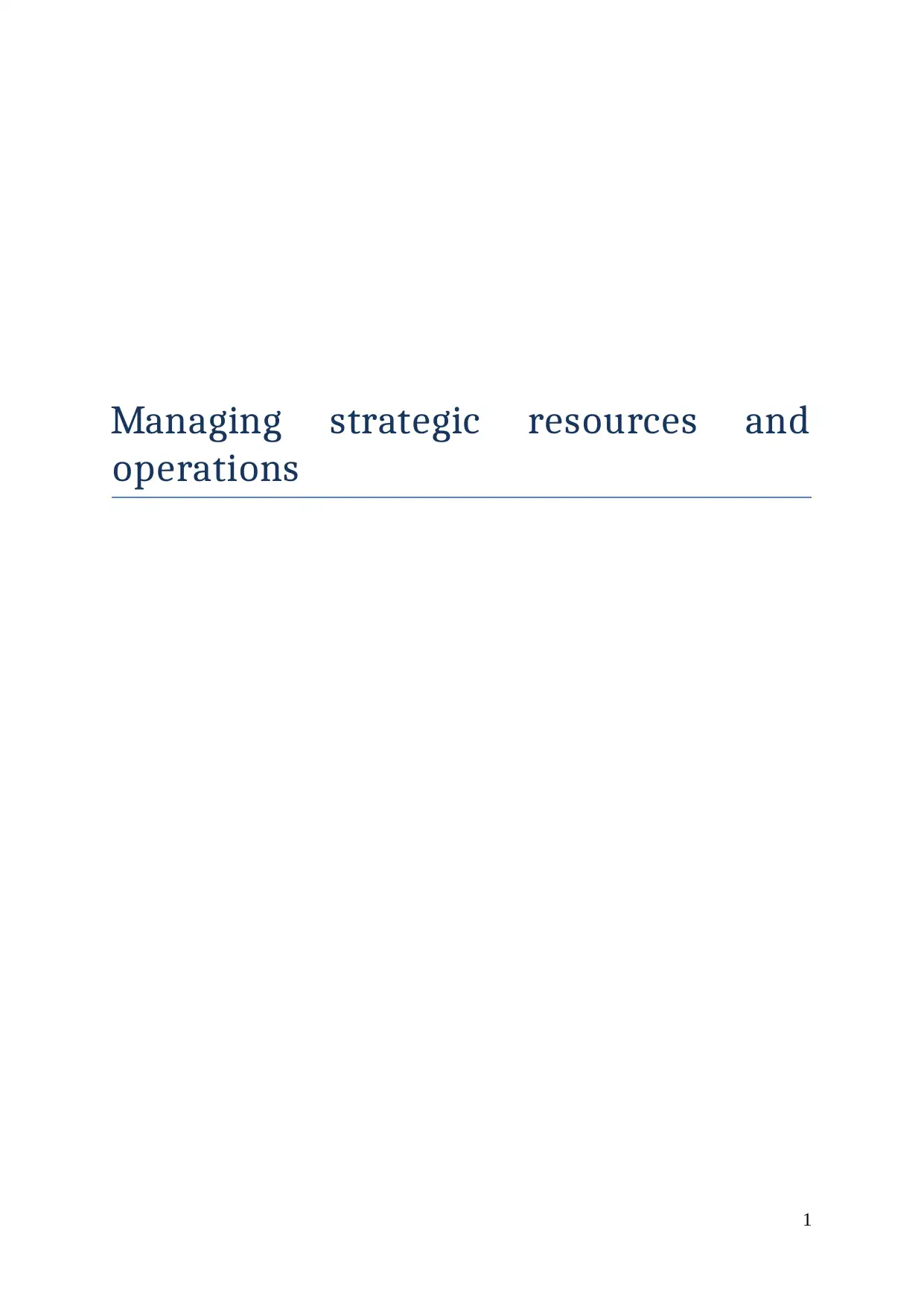
Managing strategic resources and
operations
1
operations
1
Paraphrase This Document
Need a fresh take? Get an instant paraphrase of this document with our AI Paraphraser
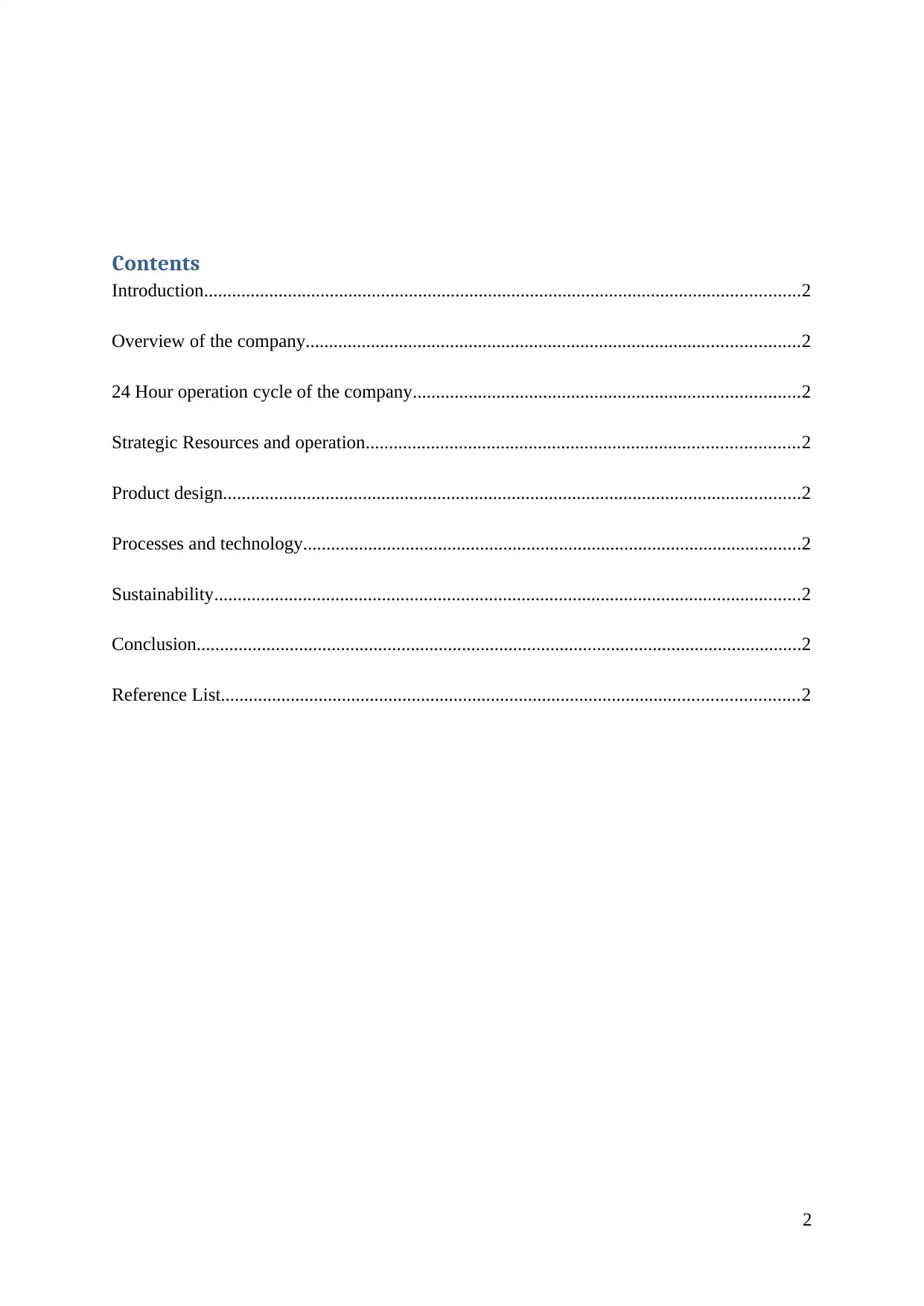
Contents
Introduction................................................................................................................................2
Overview of the company..........................................................................................................2
24 Hour operation cycle of the company...................................................................................2
Strategic Resources and operation.............................................................................................2
Product design............................................................................................................................2
Processes and technology...........................................................................................................2
Sustainability..............................................................................................................................2
Conclusion..................................................................................................................................2
Reference List............................................................................................................................2
2
Introduction................................................................................................................................2
Overview of the company..........................................................................................................2
24 Hour operation cycle of the company...................................................................................2
Strategic Resources and operation.............................................................................................2
Product design............................................................................................................................2
Processes and technology...........................................................................................................2
Sustainability..............................................................................................................................2
Conclusion..................................................................................................................................2
Reference List............................................................................................................................2
2
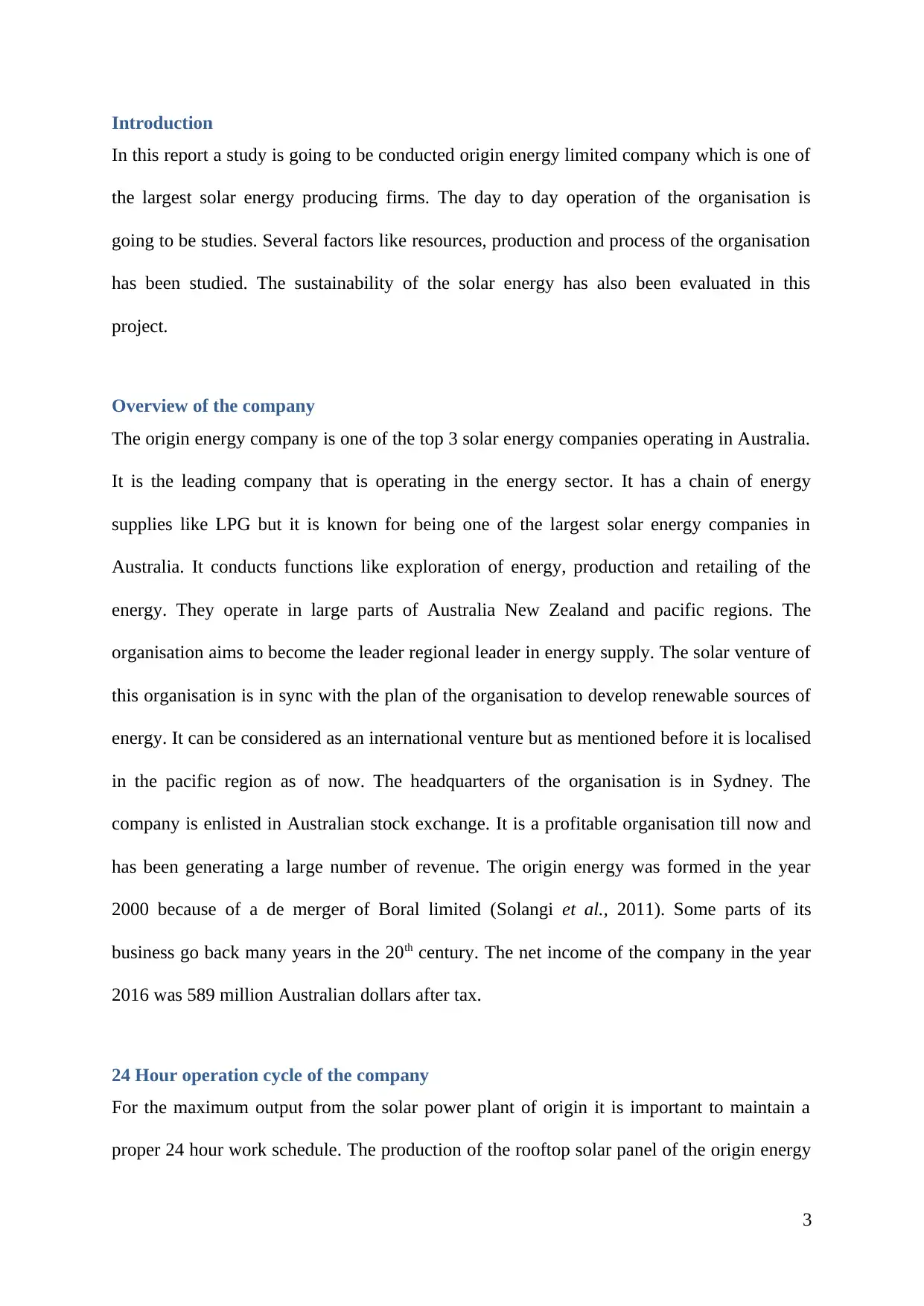
Introduction
In this report a study is going to be conducted origin energy limited company which is one of
the largest solar energy producing firms. The day to day operation of the organisation is
going to be studies. Several factors like resources, production and process of the organisation
has been studied. The sustainability of the solar energy has also been evaluated in this
project.
Overview of the company
The origin energy company is one of the top 3 solar energy companies operating in Australia.
It is the leading company that is operating in the energy sector. It has a chain of energy
supplies like LPG but it is known for being one of the largest solar energy companies in
Australia. It conducts functions like exploration of energy, production and retailing of the
energy. They operate in large parts of Australia New Zealand and pacific regions. The
organisation aims to become the leader regional leader in energy supply. The solar venture of
this organisation is in sync with the plan of the organisation to develop renewable sources of
energy. It can be considered as an international venture but as mentioned before it is localised
in the pacific region as of now. The headquarters of the organisation is in Sydney. The
company is enlisted in Australian stock exchange. It is a profitable organisation till now and
has been generating a large number of revenue. The origin energy was formed in the year
2000 because of a de merger of Boral limited (Solangi et al., 2011). Some parts of its
business go back many years in the 20th century. The net income of the company in the year
2016 was 589 million Australian dollars after tax.
24 Hour operation cycle of the company
For the maximum output from the solar power plant of origin it is important to maintain a
proper 24 hour work schedule. The production of the rooftop solar panel of the origin energy
3
In this report a study is going to be conducted origin energy limited company which is one of
the largest solar energy producing firms. The day to day operation of the organisation is
going to be studies. Several factors like resources, production and process of the organisation
has been studied. The sustainability of the solar energy has also been evaluated in this
project.
Overview of the company
The origin energy company is one of the top 3 solar energy companies operating in Australia.
It is the leading company that is operating in the energy sector. It has a chain of energy
supplies like LPG but it is known for being one of the largest solar energy companies in
Australia. It conducts functions like exploration of energy, production and retailing of the
energy. They operate in large parts of Australia New Zealand and pacific regions. The
organisation aims to become the leader regional leader in energy supply. The solar venture of
this organisation is in sync with the plan of the organisation to develop renewable sources of
energy. It can be considered as an international venture but as mentioned before it is localised
in the pacific region as of now. The headquarters of the organisation is in Sydney. The
company is enlisted in Australian stock exchange. It is a profitable organisation till now and
has been generating a large number of revenue. The origin energy was formed in the year
2000 because of a de merger of Boral limited (Solangi et al., 2011). Some parts of its
business go back many years in the 20th century. The net income of the company in the year
2016 was 589 million Australian dollars after tax.
24 Hour operation cycle of the company
For the maximum output from the solar power plant of origin it is important to maintain a
proper 24 hour work schedule. The production of the rooftop solar panel of the origin energy
3
⊘ This is a preview!⊘
Do you want full access?
Subscribe today to unlock all pages.

Trusted by 1+ million students worldwide
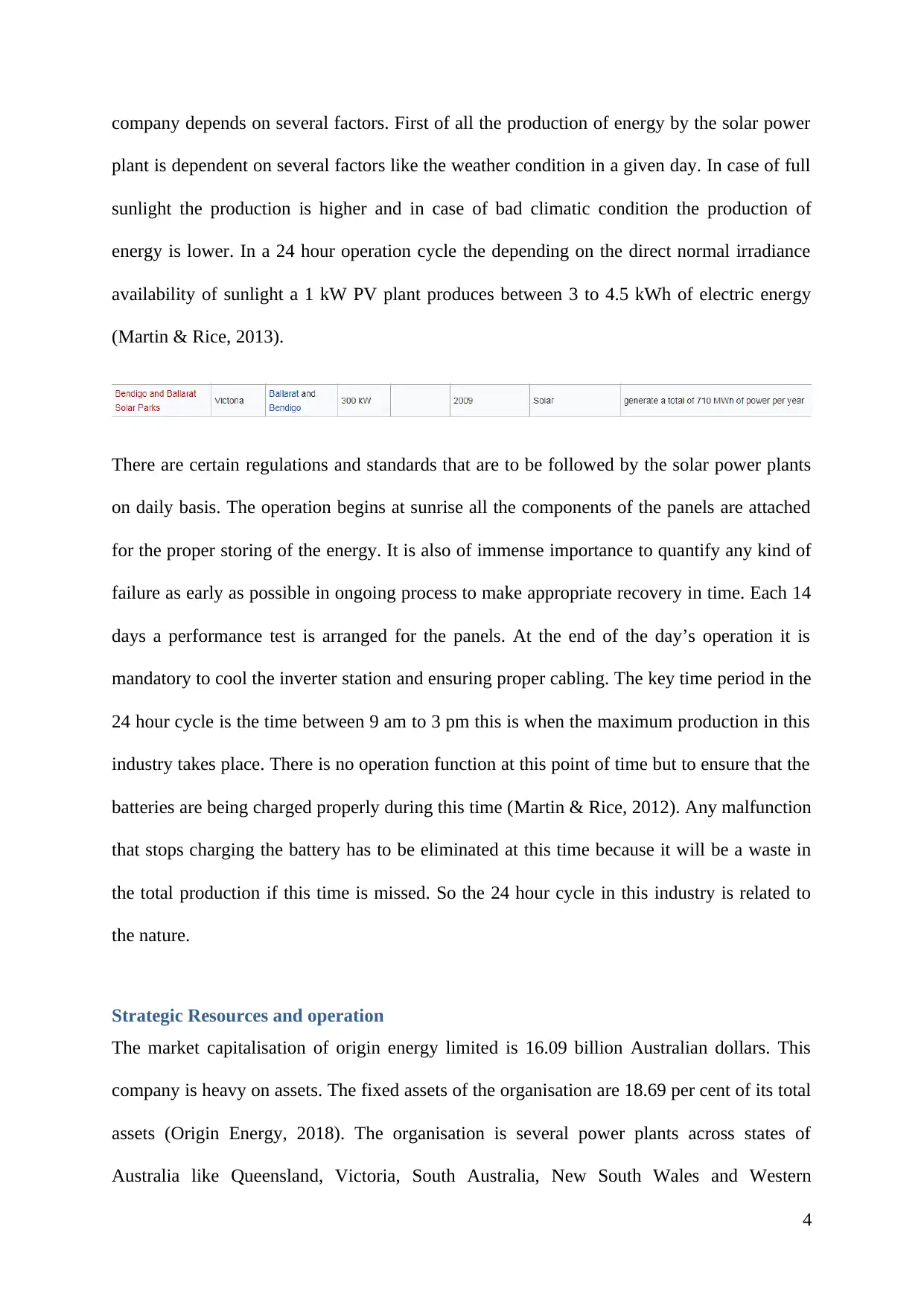
company depends on several factors. First of all the production of energy by the solar power
plant is dependent on several factors like the weather condition in a given day. In case of full
sunlight the production is higher and in case of bad climatic condition the production of
energy is lower. In a 24 hour operation cycle the depending on the direct normal irradiance
availability of sunlight a 1 kW PV plant produces between 3 to 4.5 kWh of electric energy
(Martin & Rice, 2013).
There are certain regulations and standards that are to be followed by the solar power plants
on daily basis. The operation begins at sunrise all the components of the panels are attached
for the proper storing of the energy. It is also of immense importance to quantify any kind of
failure as early as possible in ongoing process to make appropriate recovery in time. Each 14
days a performance test is arranged for the panels. At the end of the day’s operation it is
mandatory to cool the inverter station and ensuring proper cabling. The key time period in the
24 hour cycle is the time between 9 am to 3 pm this is when the maximum production in this
industry takes place. There is no operation function at this point of time but to ensure that the
batteries are being charged properly during this time (Martin & Rice, 2012). Any malfunction
that stops charging the battery has to be eliminated at this time because it will be a waste in
the total production if this time is missed. So the 24 hour cycle in this industry is related to
the nature.
Strategic Resources and operation
The market capitalisation of origin energy limited is 16.09 billion Australian dollars. This
company is heavy on assets. The fixed assets of the organisation are 18.69 per cent of its total
assets (Origin Energy, 2018). The organisation is several power plants across states of
Australia like Queensland, Victoria, South Australia, New South Wales and Western
4
plant is dependent on several factors like the weather condition in a given day. In case of full
sunlight the production is higher and in case of bad climatic condition the production of
energy is lower. In a 24 hour operation cycle the depending on the direct normal irradiance
availability of sunlight a 1 kW PV plant produces between 3 to 4.5 kWh of electric energy
(Martin & Rice, 2013).
There are certain regulations and standards that are to be followed by the solar power plants
on daily basis. The operation begins at sunrise all the components of the panels are attached
for the proper storing of the energy. It is also of immense importance to quantify any kind of
failure as early as possible in ongoing process to make appropriate recovery in time. Each 14
days a performance test is arranged for the panels. At the end of the day’s operation it is
mandatory to cool the inverter station and ensuring proper cabling. The key time period in the
24 hour cycle is the time between 9 am to 3 pm this is when the maximum production in this
industry takes place. There is no operation function at this point of time but to ensure that the
batteries are being charged properly during this time (Martin & Rice, 2012). Any malfunction
that stops charging the battery has to be eliminated at this time because it will be a waste in
the total production if this time is missed. So the 24 hour cycle in this industry is related to
the nature.
Strategic Resources and operation
The market capitalisation of origin energy limited is 16.09 billion Australian dollars. This
company is heavy on assets. The fixed assets of the organisation are 18.69 per cent of its total
assets (Origin Energy, 2018). The organisation is several power plants across states of
Australia like Queensland, Victoria, South Australia, New South Wales and Western
4
Paraphrase This Document
Need a fresh take? Get an instant paraphrase of this document with our AI Paraphraser
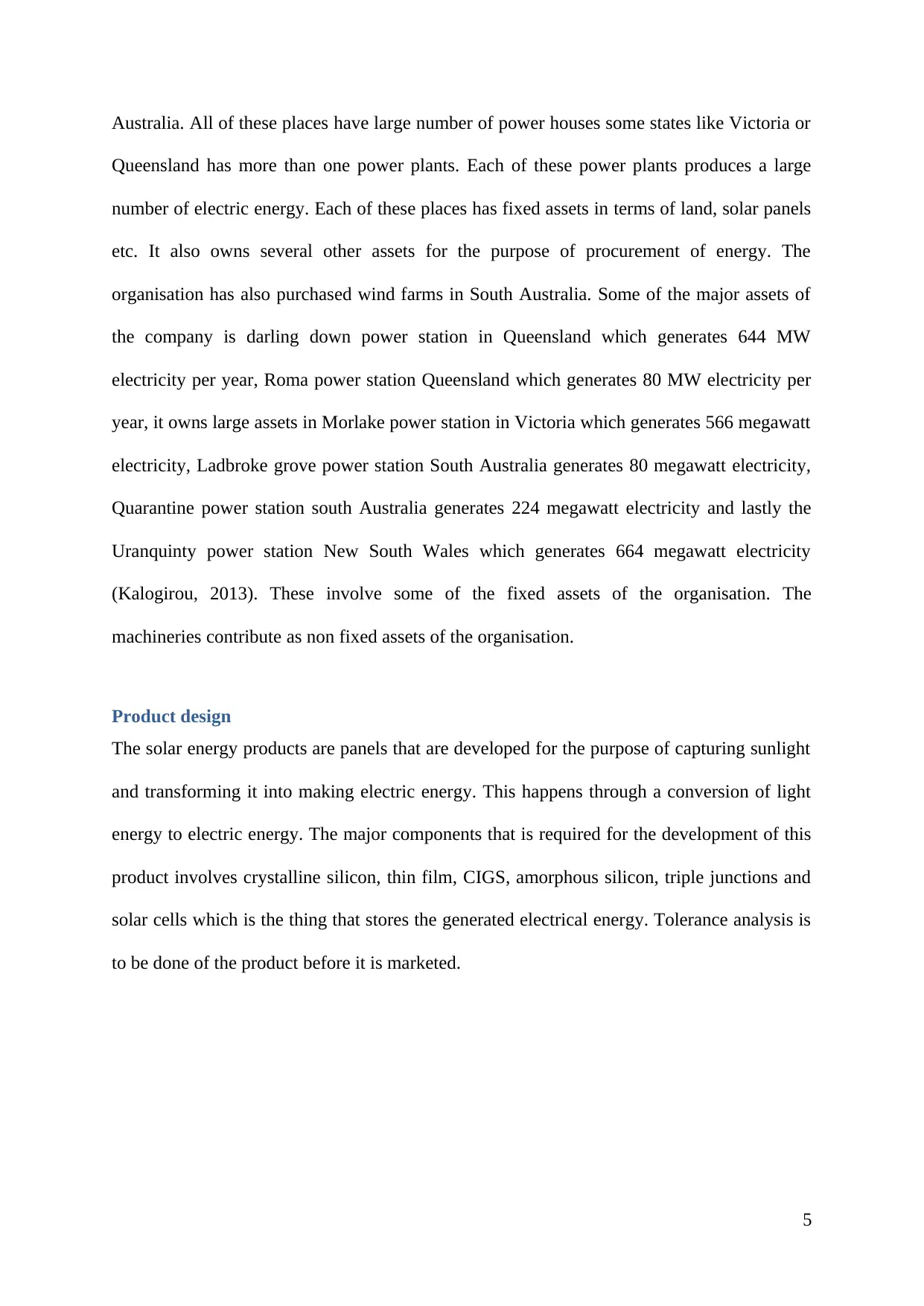
Australia. All of these places have large number of power houses some states like Victoria or
Queensland has more than one power plants. Each of these power plants produces a large
number of electric energy. Each of these places has fixed assets in terms of land, solar panels
etc. It also owns several other assets for the purpose of procurement of energy. The
organisation has also purchased wind farms in South Australia. Some of the major assets of
the company is darling down power station in Queensland which generates 644 MW
electricity per year, Roma power station Queensland which generates 80 MW electricity per
year, it owns large assets in Morlake power station in Victoria which generates 566 megawatt
electricity, Ladbroke grove power station South Australia generates 80 megawatt electricity,
Quarantine power station south Australia generates 224 megawatt electricity and lastly the
Uranquinty power station New South Wales which generates 664 megawatt electricity
(Kalogirou, 2013). These involve some of the fixed assets of the organisation. The
machineries contribute as non fixed assets of the organisation.
Product design
The solar energy products are panels that are developed for the purpose of capturing sunlight
and transforming it into making electric energy. This happens through a conversion of light
energy to electric energy. The major components that is required for the development of this
product involves crystalline silicon, thin film, CIGS, amorphous silicon, triple junctions and
solar cells which is the thing that stores the generated electrical energy. Tolerance analysis is
to be done of the product before it is marketed.
5
Queensland has more than one power plants. Each of these power plants produces a large
number of electric energy. Each of these places has fixed assets in terms of land, solar panels
etc. It also owns several other assets for the purpose of procurement of energy. The
organisation has also purchased wind farms in South Australia. Some of the major assets of
the company is darling down power station in Queensland which generates 644 MW
electricity per year, Roma power station Queensland which generates 80 MW electricity per
year, it owns large assets in Morlake power station in Victoria which generates 566 megawatt
electricity, Ladbroke grove power station South Australia generates 80 megawatt electricity,
Quarantine power station south Australia generates 224 megawatt electricity and lastly the
Uranquinty power station New South Wales which generates 664 megawatt electricity
(Kalogirou, 2013). These involve some of the fixed assets of the organisation. The
machineries contribute as non fixed assets of the organisation.
Product design
The solar energy products are panels that are developed for the purpose of capturing sunlight
and transforming it into making electric energy. This happens through a conversion of light
energy to electric energy. The major components that is required for the development of this
product involves crystalline silicon, thin film, CIGS, amorphous silicon, triple junctions and
solar cells which is the thing that stores the generated electrical energy. Tolerance analysis is
to be done of the product before it is marketed.
5
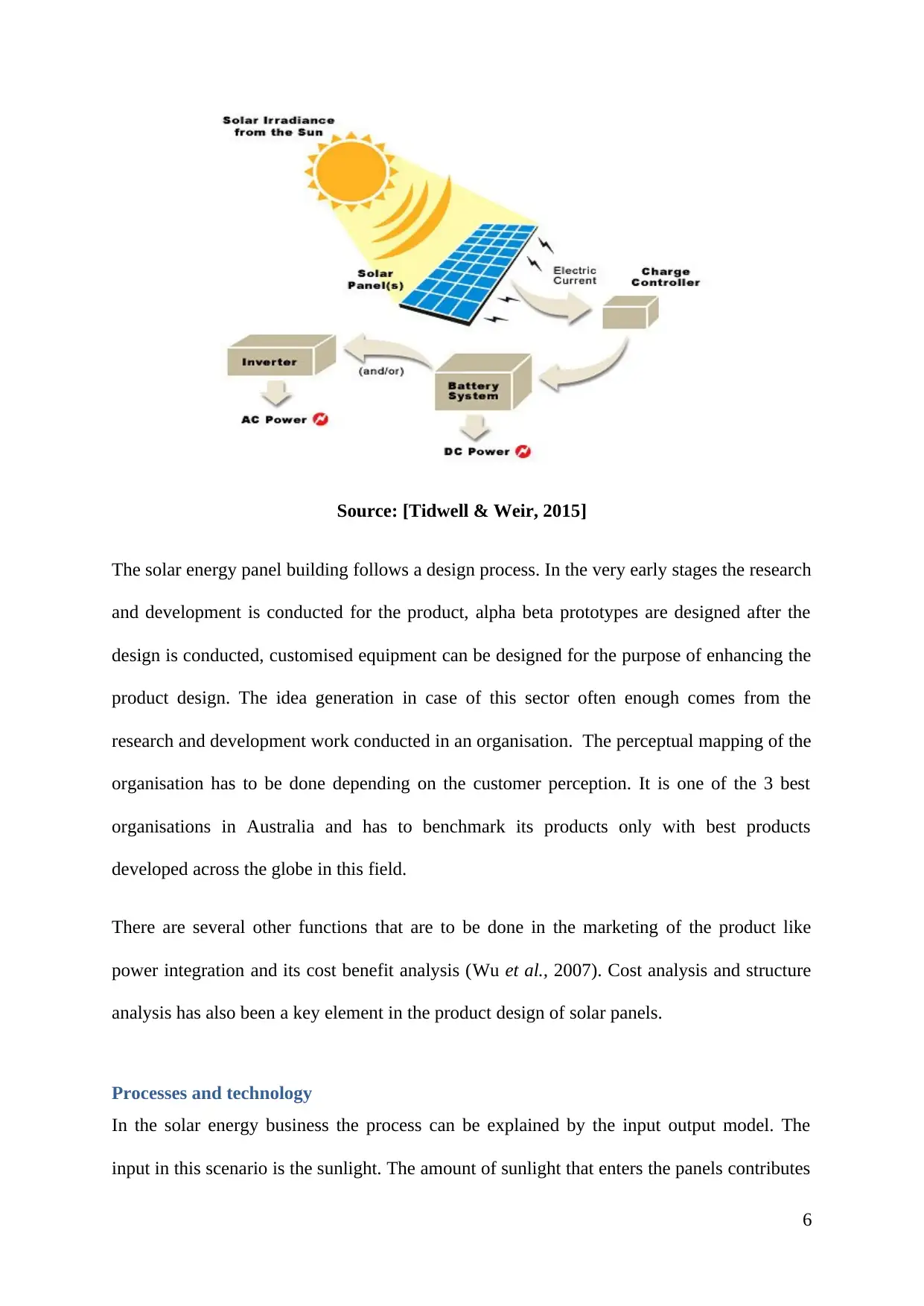
Source: [Tidwell & Weir, 2015]
The solar energy panel building follows a design process. In the very early stages the research
and development is conducted for the product, alpha beta prototypes are designed after the
design is conducted, customised equipment can be designed for the purpose of enhancing the
product design. The idea generation in case of this sector often enough comes from the
research and development work conducted in an organisation. The perceptual mapping of the
organisation has to be done depending on the customer perception. It is one of the 3 best
organisations in Australia and has to benchmark its products only with best products
developed across the globe in this field.
There are several other functions that are to be done in the marketing of the product like
power integration and its cost benefit analysis (Wu et al., 2007). Cost analysis and structure
analysis has also been a key element in the product design of solar panels.
Processes and technology
In the solar energy business the process can be explained by the input output model. The
input in this scenario is the sunlight. The amount of sunlight that enters the panels contributes
6
The solar energy panel building follows a design process. In the very early stages the research
and development is conducted for the product, alpha beta prototypes are designed after the
design is conducted, customised equipment can be designed for the purpose of enhancing the
product design. The idea generation in case of this sector often enough comes from the
research and development work conducted in an organisation. The perceptual mapping of the
organisation has to be done depending on the customer perception. It is one of the 3 best
organisations in Australia and has to benchmark its products only with best products
developed across the globe in this field.
There are several other functions that are to be done in the marketing of the product like
power integration and its cost benefit analysis (Wu et al., 2007). Cost analysis and structure
analysis has also been a key element in the product design of solar panels.
Processes and technology
In the solar energy business the process can be explained by the input output model. The
input in this scenario is the sunlight. The amount of sunlight that enters the panels contributes
6
⊘ This is a preview!⊘
Do you want full access?
Subscribe today to unlock all pages.

Trusted by 1+ million students worldwide
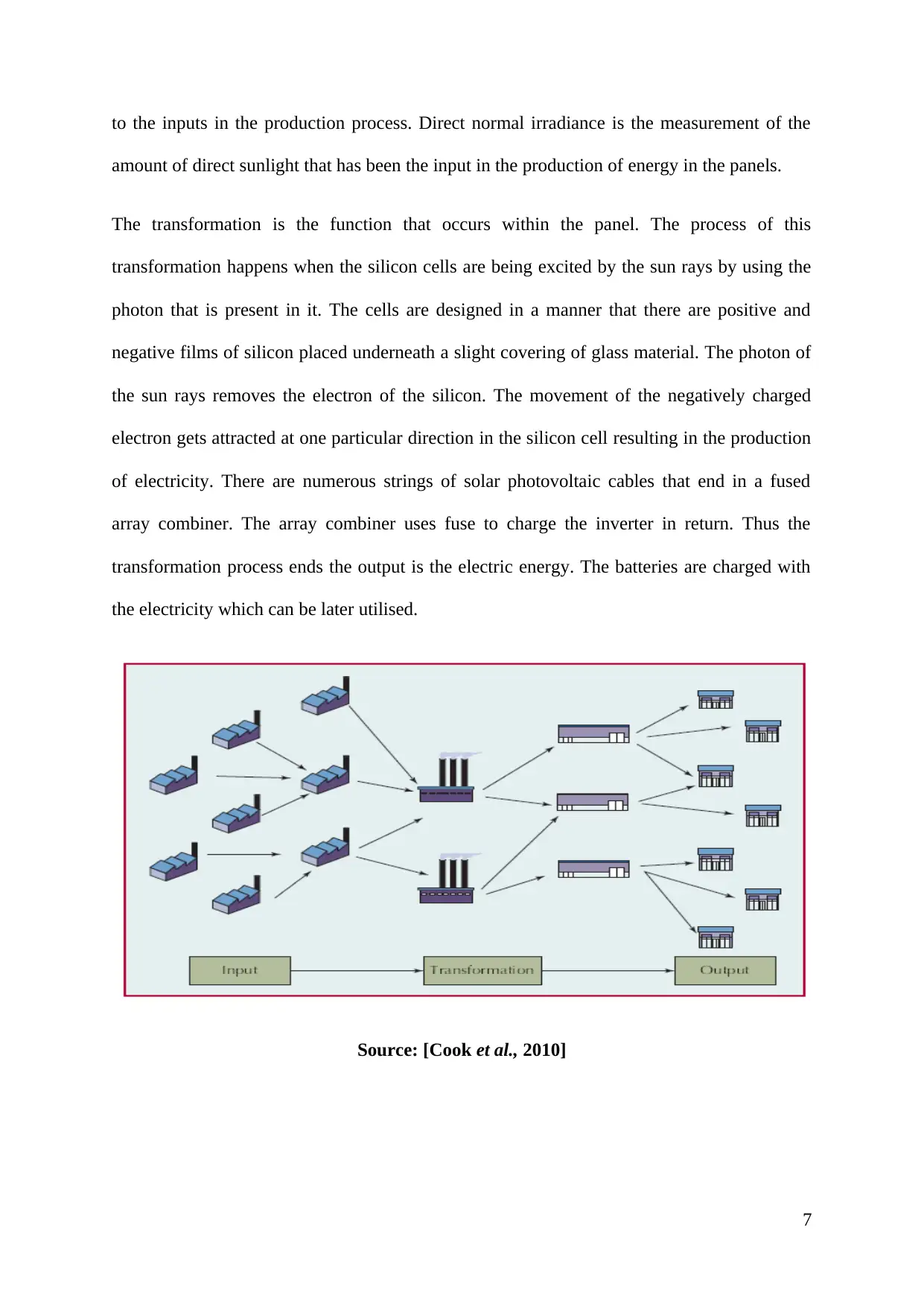
to the inputs in the production process. Direct normal irradiance is the measurement of the
amount of direct sunlight that has been the input in the production of energy in the panels.
The transformation is the function that occurs within the panel. The process of this
transformation happens when the silicon cells are being excited by the sun rays by using the
photon that is present in it. The cells are designed in a manner that there are positive and
negative films of silicon placed underneath a slight covering of glass material. The photon of
the sun rays removes the electron of the silicon. The movement of the negatively charged
electron gets attracted at one particular direction in the silicon cell resulting in the production
of electricity. There are numerous strings of solar photovoltaic cables that end in a fused
array combiner. The array combiner uses fuse to charge the inverter in return. Thus the
transformation process ends the output is the electric energy. The batteries are charged with
the electricity which can be later utilised.
Source: [Cook et al., 2010]
7
amount of direct sunlight that has been the input in the production of energy in the panels.
The transformation is the function that occurs within the panel. The process of this
transformation happens when the silicon cells are being excited by the sun rays by using the
photon that is present in it. The cells are designed in a manner that there are positive and
negative films of silicon placed underneath a slight covering of glass material. The photon of
the sun rays removes the electron of the silicon. The movement of the negatively charged
electron gets attracted at one particular direction in the silicon cell resulting in the production
of electricity. There are numerous strings of solar photovoltaic cables that end in a fused
array combiner. The array combiner uses fuse to charge the inverter in return. Thus the
transformation process ends the output is the electric energy. The batteries are charged with
the electricity which can be later utilised.
Source: [Cook et al., 2010]
7
Paraphrase This Document
Need a fresh take? Get an instant paraphrase of this document with our AI Paraphraser
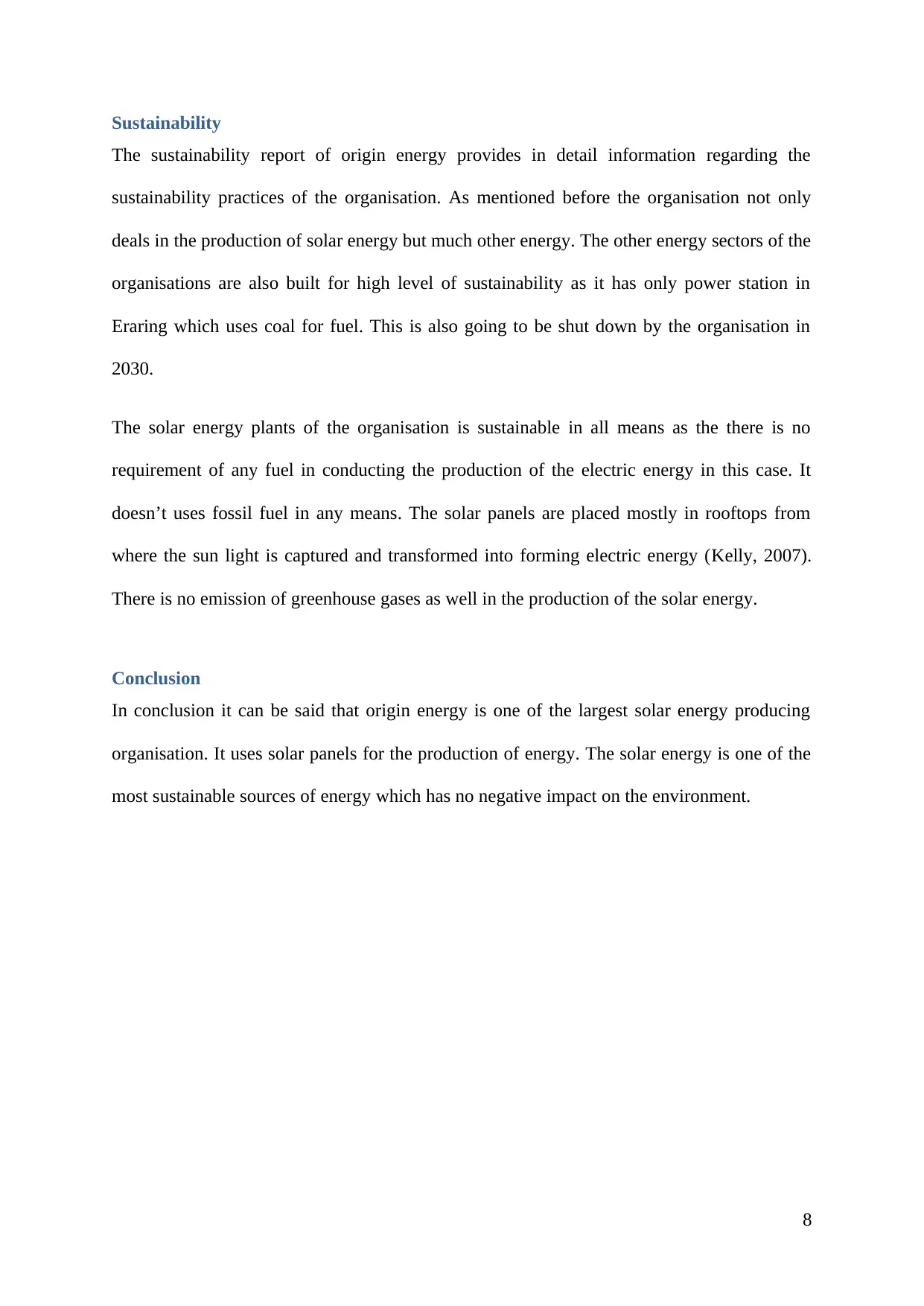
Sustainability
The sustainability report of origin energy provides in detail information regarding the
sustainability practices of the organisation. As mentioned before the organisation not only
deals in the production of solar energy but much other energy. The other energy sectors of the
organisations are also built for high level of sustainability as it has only power station in
Eraring which uses coal for fuel. This is also going to be shut down by the organisation in
2030.
The solar energy plants of the organisation is sustainable in all means as the there is no
requirement of any fuel in conducting the production of the electric energy in this case. It
doesn’t uses fossil fuel in any means. The solar panels are placed mostly in rooftops from
where the sun light is captured and transformed into forming electric energy (Kelly, 2007).
There is no emission of greenhouse gases as well in the production of the solar energy.
Conclusion
In conclusion it can be said that origin energy is one of the largest solar energy producing
organisation. It uses solar panels for the production of energy. The solar energy is one of the
most sustainable sources of energy which has no negative impact on the environment.
8
The sustainability report of origin energy provides in detail information regarding the
sustainability practices of the organisation. As mentioned before the organisation not only
deals in the production of solar energy but much other energy. The other energy sectors of the
organisations are also built for high level of sustainability as it has only power station in
Eraring which uses coal for fuel. This is also going to be shut down by the organisation in
2030.
The solar energy plants of the organisation is sustainable in all means as the there is no
requirement of any fuel in conducting the production of the electric energy in this case. It
doesn’t uses fossil fuel in any means. The solar panels are placed mostly in rooftops from
where the sun light is captured and transformed into forming electric energy (Kelly, 2007).
There is no emission of greenhouse gases as well in the production of the solar energy.
Conclusion
In conclusion it can be said that origin energy is one of the largest solar energy producing
organisation. It uses solar panels for the production of energy. The solar energy is one of the
most sustainable sources of energy which has no negative impact on the environment.
8
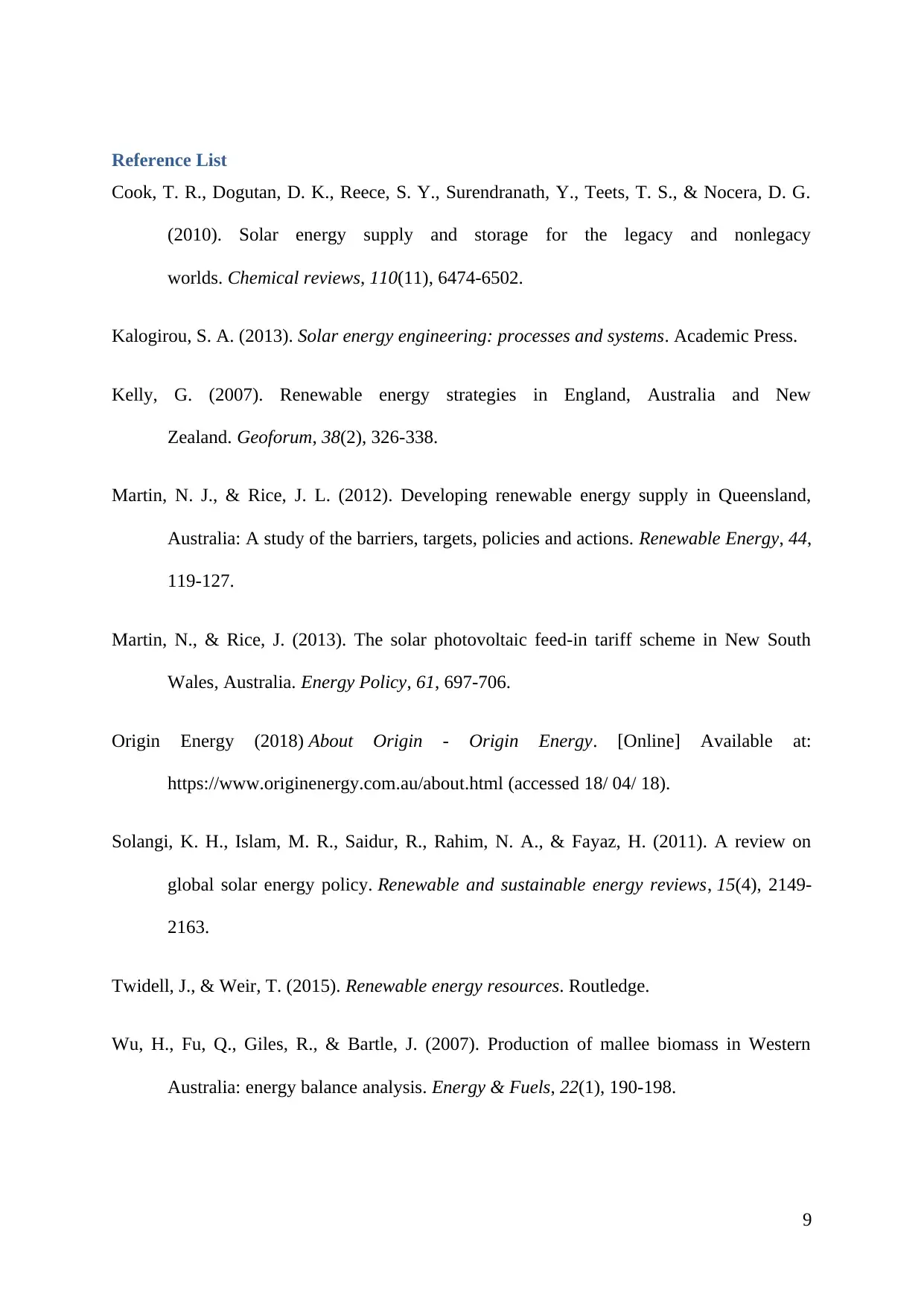
Reference List
Cook, T. R., Dogutan, D. K., Reece, S. Y., Surendranath, Y., Teets, T. S., & Nocera, D. G.
(2010). Solar energy supply and storage for the legacy and nonlegacy
worlds. Chemical reviews, 110(11), 6474-6502.
Kalogirou, S. A. (2013). Solar energy engineering: processes and systems. Academic Press.
Kelly, G. (2007). Renewable energy strategies in England, Australia and New
Zealand. Geoforum, 38(2), 326-338.
Martin, N. J., & Rice, J. L. (2012). Developing renewable energy supply in Queensland,
Australia: A study of the barriers, targets, policies and actions. Renewable Energy, 44,
119-127.
Martin, N., & Rice, J. (2013). The solar photovoltaic feed-in tariff scheme in New South
Wales, Australia. Energy Policy, 61, 697-706.
Origin Energy (2018) About Origin - Origin Energy. [Online] Available at:
https://www.originenergy.com.au/about.html (accessed 18/ 04/ 18).
Solangi, K. H., Islam, M. R., Saidur, R., Rahim, N. A., & Fayaz, H. (2011). A review on
global solar energy policy. Renewable and sustainable energy reviews, 15(4), 2149-
2163.
Twidell, J., & Weir, T. (2015). Renewable energy resources. Routledge.
Wu, H., Fu, Q., Giles, R., & Bartle, J. (2007). Production of mallee biomass in Western
Australia: energy balance analysis. Energy & Fuels, 22(1), 190-198.
9
Cook, T. R., Dogutan, D. K., Reece, S. Y., Surendranath, Y., Teets, T. S., & Nocera, D. G.
(2010). Solar energy supply and storage for the legacy and nonlegacy
worlds. Chemical reviews, 110(11), 6474-6502.
Kalogirou, S. A. (2013). Solar energy engineering: processes and systems. Academic Press.
Kelly, G. (2007). Renewable energy strategies in England, Australia and New
Zealand. Geoforum, 38(2), 326-338.
Martin, N. J., & Rice, J. L. (2012). Developing renewable energy supply in Queensland,
Australia: A study of the barriers, targets, policies and actions. Renewable Energy, 44,
119-127.
Martin, N., & Rice, J. (2013). The solar photovoltaic feed-in tariff scheme in New South
Wales, Australia. Energy Policy, 61, 697-706.
Origin Energy (2018) About Origin - Origin Energy. [Online] Available at:
https://www.originenergy.com.au/about.html (accessed 18/ 04/ 18).
Solangi, K. H., Islam, M. R., Saidur, R., Rahim, N. A., & Fayaz, H. (2011). A review on
global solar energy policy. Renewable and sustainable energy reviews, 15(4), 2149-
2163.
Twidell, J., & Weir, T. (2015). Renewable energy resources. Routledge.
Wu, H., Fu, Q., Giles, R., & Bartle, J. (2007). Production of mallee biomass in Western
Australia: energy balance analysis. Energy & Fuels, 22(1), 190-198.
9
⊘ This is a preview!⊘
Do you want full access?
Subscribe today to unlock all pages.

Trusted by 1+ million students worldwide

10
1 out of 10
Related Documents
Your All-in-One AI-Powered Toolkit for Academic Success.
+13062052269
info@desklib.com
Available 24*7 on WhatsApp / Email
![[object Object]](/_next/static/media/star-bottom.7253800d.svg)
Unlock your academic potential
Copyright © 2020–2025 A2Z Services. All Rights Reserved. Developed and managed by ZUCOL.





